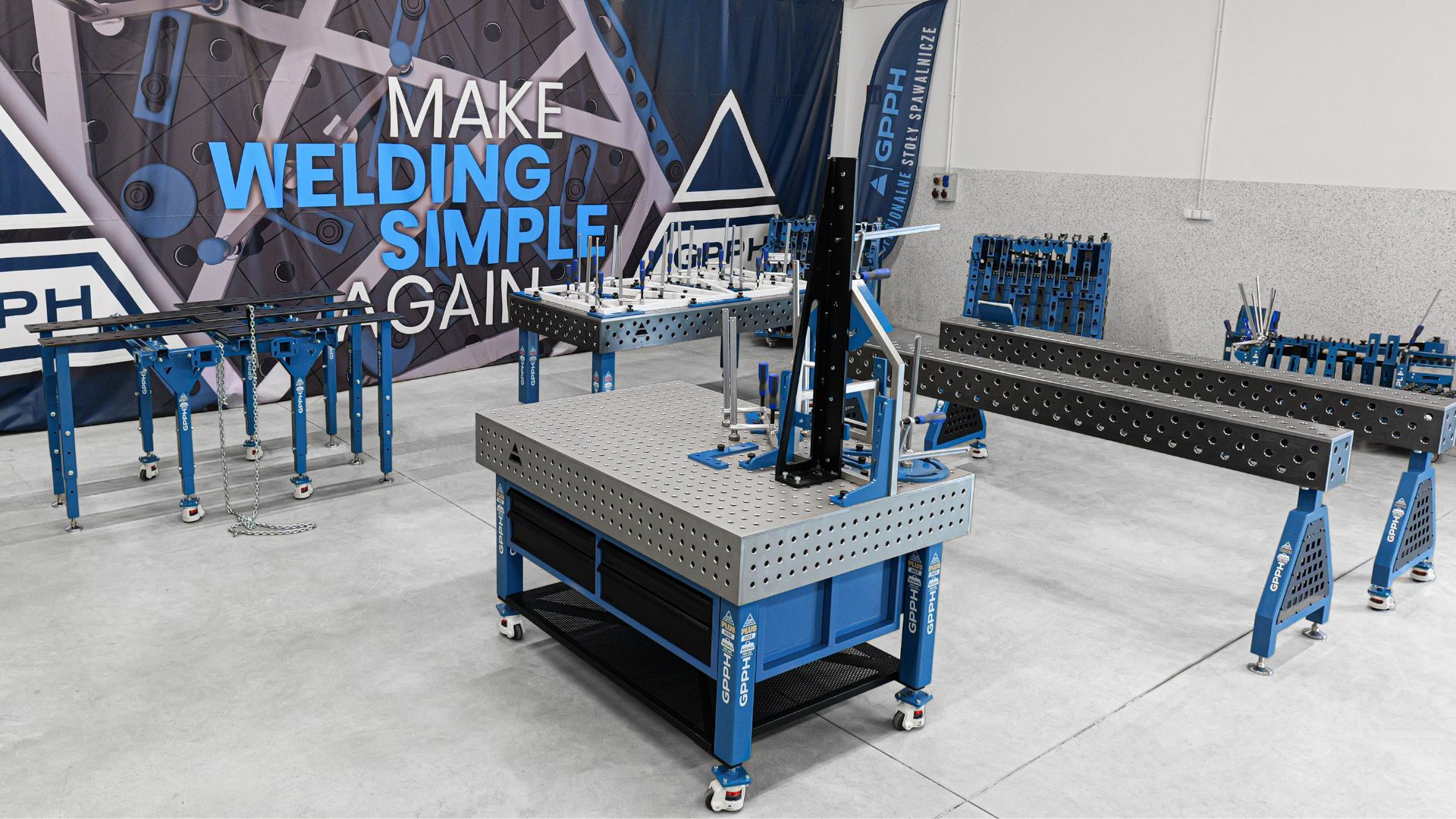Spawanie to wymagające umiejętności zajęcie, które wymaga precyzji, praktyki i odpowiedniego sprzętu. Dla początkujących, rozpoczęcie pracy ze stołem spawalniczym może zapewnić stabilne i niezawodne miejsce pracy, które usprawni naukę i rozwój umiejętności. Niniejszy przewodnik obejmuje podstawowe umiejętności i pierwsze kroki dla początkujących pracujących przy stole spawalniczym, oferując wgląd w podstawowe techniki i wskazówki ułatwiające rozpoczęcie pracy.
Wprowadzenie do spawania na stole spawalniczym
Stół spawalniczy to płaska, stabilna powierzchnia zaprojektowana specjalnie do zadań spawalniczych. Zapewnia bezpieczną i regulowaną platformę do przytrzymywania obrabianych przedmiotów, zapewniając precyzję i bezpieczeństwo podczas spawania. Wysokiej jakości stoły spawalnicze, takie jak te produkowane przez GPPH Group, oferują funkcje takie jak modułowe uchwyty i precyzyjne powierzchnie, które są idealne zarówno dla początkujących, jak i doświadczonych spawaczy. Poznaj stoły spawalnicze premium Grupy GPPH tutaj.
Podstawowe umiejętności dla początkujących spawaczy
- Zrozumienie rodzajów spawania: Pierwszym krokiem w spawalnictwie jest zrozumienie różnych rodzajów procesów spawalniczych, takich jak MIG (Metal Inert Gas), TIG (Tungsten Inert Gas) i spawanie elektrodą otuloną. Każdy typ ma swoje własne zastosowania, zalety i techniki.
- Bezpieczeństwo przede wszystkim: Spawanie wiąże się z wysokimi temperaturami, promieniowaniem UV i niebezpiecznymi oparami. Należy zawsze nosić odpowiednie środki ochrony indywidualnej (ŚOI), w tym przyłbicę spawalniczą o odpowiednim odcieniu, rękawice ognioodporne, koszule z długim rękawem i okulary ochronne.
- Czytanie planów i schematów: Zrozumienie, jak czytać i interpretować plany i schematy spawalnicze jest niezbędne. Dokumenty te zawierają szczegółowe instrukcje dotyczące typów spoin, pozycji i specyfikacji wymaganych dla danego projektu.
- Przygotowanie materiału: Oczyść metalowe powierzchnie, aby usunąć wszelkie zabrudzenia, rdzę lub olej. Odpowiednie przygotowanie zapewnia lepszą jakość spoiny i zapobiega zanieczyszczeniu jeziorka spawalniczego.
Pierwsze kroki na stole spawalniczym
- Konfiguracja stołu spawalniczego: Stół spawalniczy należy ustawić w dobrze wentylowanym miejscu, aby uniknąć wdychania szkodliwych oparów. Upewnić się, że stół jest wypoziomowany i zabezpieczony przed przemieszczaniem się podczas spawania.
- Zabezpieczanie przedmiotów obrabianych: Używaj zacisków i uchwytów, aby mocno przytrzymać obrabiane elementy. Stoły spawalnicze GPPH Group są zaprojektowane z modułowymi uchwytami, które pozwalają na precyzyjne i bezpieczne pozycjonowanie materiałów. Taka konfiguracja jest kluczowa dla utrzymania dokładności i stabilności podczas spawania.
- Regulacja spawarki: Skonfiguruj spawarkę zgodnie z rodzajem wykonywanego spawania. Dostosuj parametry, takie jak napięcie, natężenie prądu i prędkość podawania drutu w zależności od grubości i rodzaju metalu. Prawidłowe ustawienia mają kluczowe znaczenie dla uzyskania mocnych, czystych spoin.
- Praktyka czyni mistrza: Rozpocznij od spawania próbnego na złomie, aby zapoznać się z procesem. Skoncentruj się na kontrolowaniu palnika spawalniczego, utrzymywaniu stałej prędkości i uzyskiwaniu stabilnego ściegu spoiny.
Podstawowe techniki spawania
- Napawanie: Rozpocznij od sczepienia elementów. Spoiny sczepne to małe spoiny, które utrzymują elementy na miejscu i zapobiegają ich przemieszczaniu się podczas końcowego procesu spawania.
- Połączenia doczołowe: Jest to powszechna technika spawania, w której dwa kawałki metalu są łączone krawędź w krawędź. Upewnij się, że krawędzie są wyrównane i użyj zacisków, aby utrzymać je na miejscu. Nałóż spoinę wzdłuż szwu, utrzymując stabilną rękę i stałą prędkość.
- Spoiny pachwinowe: Spoiny pachwinowe łączą dwa kawałki metalu pod kątem prostym. Ten rodzaj spoiny jest powszechnie stosowany do spawania konstrukcji metalowych i ram. Umieść elementy bezpiecznie i poprowadź ścieg spoiny wzdłuż złącza, zapewniając dobre wtopienie i gładkie wykończenie.
- Kontrola ściegu spoiny: Należy ćwiczyć utrzymywanie stałej długości łuku i prędkości przesuwu. Stała kontrola palnika spawalniczego zapewnia jednolite ściegi spoiny i zmniejsza prawdopodobieństwo wystąpienia wad.
Wspólne wyzwania i rozwiązania
- Rozpryski spawalnicze: Nadmierne rozpryski spawalnicze można zminimalizować poprzez dostosowanie parametrów spawania i zapewnienie czystych powierzchni roboczych. Spraye antyodpryskowe mogą również pomóc ograniczyć gromadzenie się odprysków na stole spawalniczym i elementach spawanych.
- Zniekształcenie: Ciepło spawania może spowodować wypaczenie lub zniekształcenie metalu. Aby temu zapobiec, należy używać zacisków do przytrzymywania elementów na miejscu i spawać w sekwencji, która równomiernie rozprowadza ciepło. Wstępne podgrzanie metalu może również zmniejszyć ryzyko odkształcenia.
- Porowatość: Porowatość spoin jest spowodowana przez uwięzione gazy. Należy zapewnić odpowiednie pokrycie gazem osłonowym i dokładnie oczyścić metalowe powierzchnie, aby uniknąć zanieczyszczenia. Regulacja natężenia przepływu gazu może również pomóc w zmniejszeniu porowatości.
- Pękanie: Pęknięcia w spoinach mogą wystąpić z powodu niewłaściwych technik spawania lub niekompatybilnych materiałów. Aby zmniejszyć ryzyko pęknięć, należy stosować odpowiednie spoiwo i podgrzewać grubsze materiały. Utrzymuj stałą, kontrolowaną prędkość spawania, aby zapewnić solidną spoinę.
Wnioski
Spawanie na stole spawalniczym oferuje początkującym stabilną i wydajną platformę do rozwijania swoich umiejętności. Postępując zgodnie z tymi podstawowymi krokami i technikami, początkujący mogą uzyskać mocne, wysokiej jakości spoiny. Inwestycja w wysokiej jakości stół spawalniczy, taki jak te od GPPH Group, zapewnia niezawodną i precyzyjną podstawę dla każdego projektu spawalniczego. Odwiedź stronę internetową Grupy GPPH aby zapoznać się z ofertą innowacyjnych stołów spawalniczych i akcesoriów.
Opanowując te początkowe umiejętności i pokonując typowe wyzwania, początkujący mogą zbudować solidne podstawy spawania, torując drogę do bardziej zaawansowanych technik i złożonych projektów. Dzięki praktyce, dbałości o szczegóły i odpowiedniemu sprzętowi, każdy może stać się biegły w spawaniu na stole spawalniczym.

